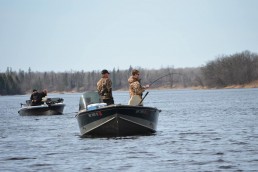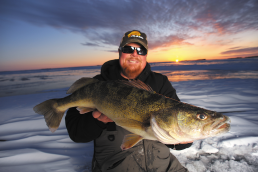Are You an Ethical Angler?
SHARE THIS POST
It was a beautiful fall day on the Rainy River. I was fishing with my brother for walleyes the day before a small resort-fishing tournament. The goal was to figure out where some were, but more importantly, enjoy time together on the river. We were fishing a deep hole in a bend of the river where I thought there could be some Rainy gold.
We were there a short time when I hooked into something nice. In fact, it appeared to be “too nice” as it ripped out drag.
I told my brother, “Probably a small sturgeon.”
I started horsing it in fairly quickly, and it finally revealed itself. It was not a sturgeon, but a big walleye. Jim scooped it in the net and all was good.
I wanted to make a video sharing some of the fall-fishing opportunities on this famous rive, and what better time to do so than with a 28 1/2-inch walleye. I had the camera ready to go just in case. Jim—knowing by now that I needed his amateuristic video skills from time to time—gave me the sign he was recording. We then made the video of me holding that fat walleye. I released the fish and it took off into the murky depths.
I posted the video to the Lake of the Woods’ Tourism Facebook page. And I was surprised at a few of the responses. Some people don’t mince words, so basically a few anglers who care about fish thought the walleye was out of the water too long while I was filming our short video.
At first, I was taken aback. But then after thinking about it, I questioned myself. I came to the conclusion that the walleye was not hurt in any way, as the water was cold and I pulled her in relatively quick. I truly believe that and felt better. Then I started to wonder if I could’ve made a shorter video or had released the fish earlier in the video, reducing potential harm to the ‘eye while still achieving my message without the brain damage of scrutiny.
Was I unethical for taking too much time with the fish out of the water? Do people think I am unethical?
There was another situation—this time ice fishing.
Once I had the privilege to be fishing out of a resort fish house with some fellow outdoor writers. The day was very cold and the fishing wasn’t what I had hoped for with such an esteemed group as we were picking at the saugers and very average-sized walleyes.
I saw a big red line on my Vexilar and told my friend from Illinois sitting next to me to check it out. I showed him how to jig the jigging line when you see a fish on your flasher. Then the bobber on the
deadstick started to go underwater. I shifted over to show him how I tighten the line, feel the fish and set the hook.
Are you enjoying this post?
You can be among the first to get the latest info on where to go, what to use and how to use it!
It was a decent fish.
After about halfway up, it took off for the bottom. Clearly, this was a good fish—I called a pike, eelpout or a big walleye.
There were a couple of good runs with water surging up and down in my hole, and the fish was getting close. We got our first glimpse through the stained water of two massive glowing eyeballs surrounded by a big gold head and a mouth full of teeth.
It was a big walleye.
One of my friends took the liberty (with me watching closely, ready to dive into the hole) of sliding a few fingers under the gill plate to hoist the 31-inch walleye out of the hole. As you can imagine, this had everyone’s attention and the energy level in our fish house rose dramatically.
As outdoor media, we all had our cameras and understand these opportunities do not happen every day. We took some photos inside the house and a few outside. After a number of shots, I wanted to get the big girl back in the water. I spent more than 30 minutes working on reviving that fish. The gills would move slowly and the pectoral fins would move slowly, but she just didn’t have it in her to kick down the hole.
Feeling very badly, I made the decision this walleye just wasn’t going to make it and decided to mount her. It is the only walleye I have mounted, and was a legal length to keep. I enjoy looking at the mount and reliving that special day. I will never forget it. But I ask myself, Should I have taken a quick few pics and tried to get her back right away?”
Anglers catch big fish all the time on Lake of the Woods. The sturgeon there are especially big and get to be over 6 feet. Is it unethical fishing these beasts with normal spinning gear and not having heavy rods, reels and line, which minimizes how long you fight it and ultimately how tired out the sturgeon gets? Is it ethical for an angler to hold a sturgeon vertically vs. horizontally, which can actually tear its internal organs by its sheer size?
For other species, is it unethical to release crappies back down a hole when ice fishing in depths of more than 25 feet of water, knowing that although they swim back down the hole, a large percentage won’t survive? And what about catching and keeping big bull sunfish, even though they’re the gene pool you want to keep in a lake and you know there are plenty of averaged-sized fish to keep that won’t affect the quality of fish down the road?
Also, how close should or can I fish next to another boat or fish house? If I see someone catch a fish, is it all right for me to go closer and to fish right by them?
As anglers, we are faced with decisions every day. In many cases, one can be within the law, but perhaps skirt the ethical litmus test. Some of the answers to these questions are tough, as there is grey area and there are anglers who truly want to do the right thing but perhaps just don’t know what the right thing exactly is.
From time to time, it’s good for all of us to have some self-reflection on how we do things. I know I have.
MWO
SHARE THIS POST
Did you enjoy this post?
You can be among the first to get the latest info on where to go, what to use and how to use it!
Joe Henry
Tournament angler and licensed charter captain Joe Henry fishes and hunts the Midwest. Henry is a media member of AGLOW and writes for numerous publications, creates videos, appears on a variety of outdoor TV and radio shows and is a frequent seminar speaker. Henry is the Executive Director of Lake of the Woods Tourism.



